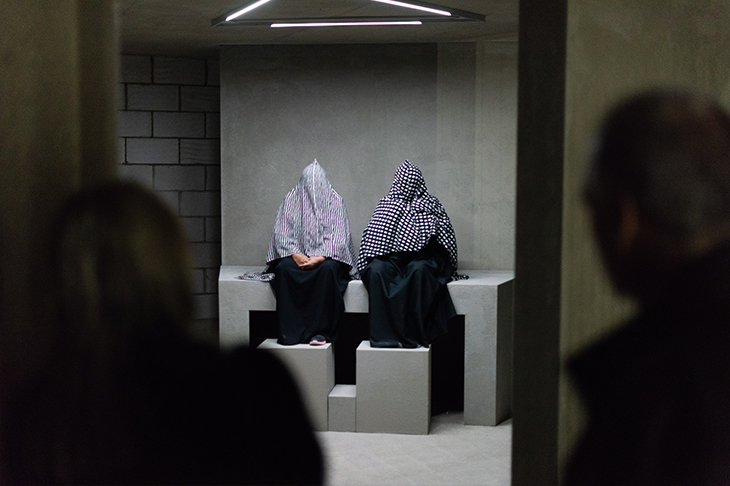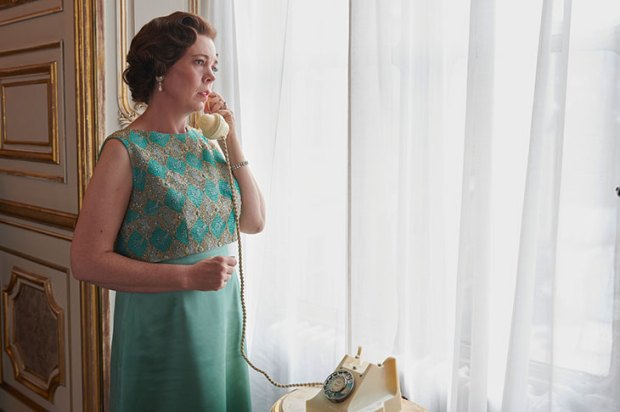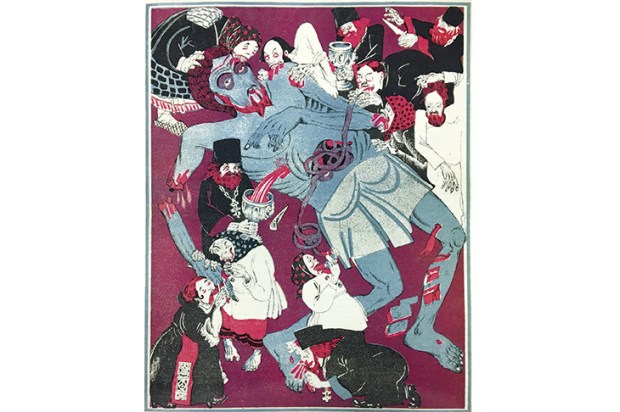They enter two by two. Grannies, mainly. Headscarved, mainly. Some locking arms. A bit glum. Like rejects from Noah’s ark. Passing through two vertical beams of light, they appear then disappear, shuffling into the darkness. From concrete caves, they begin to wail for the dead.
We’re witnessing Artangel’s latest extraordinary commission, ‘An Occupation of Loss’, by Taryn Simon. The piece draws together professional mourners from all corners of the earth — China, Armenia, Ghana, Ecuador — and deposits them under a block of flats in Islington High Street.
The Azerbaijanis wallop their thighs as they wail. The Venezuelans sob behind full face veils, the fabric vibrating in sympathy. Some pace in circles, nervously fingering bits of cloth. Some grieve only for women — no men allowed. The shrunken Albanian lady, her vocal cords reduced to gravel, just sits and talks, deep in conversation with the afterlife. Unnerving, bewitching, fascinating.
Most fascinating was how unmoving it all was. It’s hard to be moved by a market, a cacophonous souk of grief-conjurors and master manipulators. It was easy to be captivated, though. One pair of biddies from Ghana whimpered directly at you, following you with creased faces, imploring hands, tissues dabbing dry eyes, begging you to award them your attention.
The one to book for Auntie Marge’s funeral? Go for the skilful Greek trio, the woman soaring and swooping and skidding about over the top of the two hollering males. I must mention also what splendid handbags everyone had: big, glossy bricks of mystery, perched next to the mourners like obedient pets. Do they come with the job?
For those sceptical about performance art, suspicious of the point of it all, here was a challenge. Where else could I have experienced this Stygian ceremony? Liberated from narrative, performance art can play and roam in a unique way. Drag you into a Kyrgyz grave, for example. Or make you look again at something as basic as kissing.
What a strange activity. Two slimy muscles locked in almost violent embrace. To an alien it must look like cannibalism. In a south London community arts centre, artist Florence Peake and dancer Eve Stainton were exploring intimacy — and each other. Recharging the smooch with so much sensuality and oddity that it became explicit, almost obscene. Which was strange as they had just spent the past 15 minutes drawing around each other’s vaginas with pens. That should have been the explicit bit. It wasn’t. That was merely a playful and ticklish curtain-raiser to the intensity of that burst of sucking and chewing and licking.
It was the heart of their brilliant, brave, frequently hilarious work Slug Horizons. Before and after the heavy petting, they played with limbs, locking arms and legs in configurations of support and attempted equilibrium. All the while they improvised stories, spontaneous, intimate, slumber party-ish delights.
Performance has come a long way since the austere, knowing trolling of the first generation. One of the more fidgety veterans, 82-year-old Joan Jonas, subject of an ongoing Tate retrospective, was in town bellowing through metal cones, jumping through hoops, masking herself, singing, doodling, running.
‘Mirror Piece II’ (1970/2018) is her machine for mincing space. A dozen full-length mirrors danced across the Tate Tanks, chopping up the audience, ceiling and floor, making them pitch and plunge, transforming solids into liquids — a dispenser of instant cubism. In ‘Volcano Film’ (1976), the octogenarian runs — enthusiastically; desperately — towards a spewing volcano, now submerged by lava, now reappearing in the bright-white flames, diving in and out of the eructions like a deranged Rhinemaiden. Mysteriously thrilling. Catch her (if you can) on 31 May, back at Tate Tanks.
Jonas turned to performance believing painting and sculpture had exhausted itself. Boy, did you get a sense of exhaustion at Glasgow International. I saw 37 shows. One stayed with me. An astonishing film at the Hunterian Gallery. Ulrike Ottinger’s eye-popping Superbia (1986), a surreal procession of allegorical grotesques. The film Hieronymous Bosch might have made if he’d had a BFI season pass.
At the Volksbühne in Berlin, I felt close to death — in the best possible way. Fever Room by the great Thai filmmaker Apichatpong Weerasethakul (Ah-peach-ah-pong We’re-ascetical) starts off conventionally enough with multiple screens relaying the drowsy world of his movies. The screens begin to fly. Then vanish. Curtains open, revealing we’re on stage and looking out on to the auditorium, smoke swirling around a single lamppost. A strobe shapes the vapour into tunnels and landscapes. Beings scuttle, monkey-like, down the smoke trails. Rather like a near-death experience, it was disorientating and transcendental, and a tiny bit Wagnerian, if the words ‘tiny’ and ‘Wagnerian’ are allowed in the same sentence.
Opera used to have a near monopoly on the disorientating and transcendental. Today craven companies like the Royal Opera House prefer the prosaic legibility of things like George Benjamin’s Lessons in Love and Violence. Has there been a more overhyped opera in history? People declared it ‘historic’ before a note had sounded. Martin Crimp’s libretto and Katie Mitchell’s staging were simultaneously pedestrian and pretentious. The score was classic Benjamin. Technically impeccable. The orchestration superbly clever and correct and inert. Lessons in smugness and selling out.
There was more creativity, generosity, electricity, in the first 15 minutes of the experimental music and arts festival Odrathek, which opened with a new piece by Claudia Molitor and Joseph Kohlmaier, than in all of Crimp and Benjamin’s collaborations. Die Gedanken sind Frei sees Kohlmaier’s choir Musarc turned into an earth-shovelling workforce, chanting and whistling as they shifted a ton of prime soil across a vast former fire-engine workshop in Lambeth. Simple ingredients setting off something elementally magnificent, a strange ennoblement of work and indictment of it, sending the mind and ear shooting off through history to the medieval Russia of Andrei Rublev in the metallic clang of dragged shovels and Orthodox-like peal of voices. And you could probably have produced it for the cost of the Benjamin opera and still have had a million pounds left over.
Got something to add? Join the discussion and comment below.
Get 10 issues for just $10
Subscribe to The Spectator Australia today for the next 10 magazine issues, plus full online access, for just $10.
You might disagree with half of it, but you’ll enjoy reading all of it. Try your first month for free, then just $2 a week for the remainder of your first year.















Comments
Don't miss out
Join the conversation with other Spectator Australia readers. Subscribe to leave a comment.
SUBSCRIBEAlready a subscriber? Log in